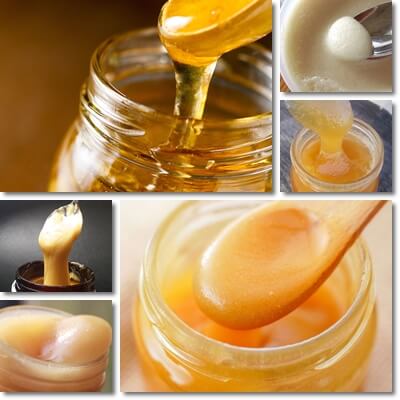Creamed honey is a type of honey spread made from crystallized liquid honey. It has a soft, smooth consistency that feels pleasant on the tongue, vs naturally crystallized honey which is rough and gritty. It is also known as whipped, spun, churned or set honey, and even honey butter or fondant, names hinting at the way it’s made and indicating it has a thick, soft, creamy, buttery consistency – but they are all the same thing.
Find out below how creamed honey is made, how to make it yourself at home, and even add flavors to it, and what benefits it provides for the consumers.
What is creamed honey?
Creamed honey is a variety of processed crystallized honey. Just as its name says, it’s a honey that is cream-like in texture. Normally, honey is liquid at first, but crystallizes after a while, which is a perfectly natural process (different varieties will crystallize in different time frames). When raw honey crystallizes naturally, the sugars in it form sizable crystals that give it a rougher, grittier texture and solidify it to the point it can become difficult to scoop out of the jar to eat. Adding finer sugar crystals to a liquid honey triggers the crystallization process, but instead of forming large sugar crystals that cause a rough, gritty texture, the honey forms smaller, finer crystals that give it a soft, smooth consistency and texture.

How is creamed honey made?
If you were wondering how to make creamed honey, then know it’s not the easiest process. In an industrial setting, raw liquid honey is pasteurized and filtered to remove any impurities (including healthy ones such as beeswax, pollen grains or propolis particles). The pasteurization is done to both help the honey pass through finer filtration systems, helping achieve a clearer product, and to destroy naturally-occurring microorganisms such as yeasts with the purpose of preventing fermentation and spoilage. After that, the honey is allowed to cool.
Then a starter or seed is added to jump start the crystallization process. The starter is basically creamed honey. The starter is mixed in well with the liquid honey so the finer crystals in it disperse throughout the liquid honey and trigger the crystallization process.
Given that the starter crystals are small and fine, the rest of the liquid honey will follow suit and crystallize in the same pattern, resulting a smooth, creamy product that is spreadable. According to the Dyce method, the honey is best kept at a temperature of about 14 degrees Celsius during the solidification process to encourage crystal formation. The ratio of creamed honey to pasteurized liquid honey ranges from 1:1 to 10:1, depending on various factors.
For a more natural final product that more closely resembles raw honey in terms of properties and health benefits, pasteurization is avoided. Raw, liquid honey is strained to remove bigger impurities (straining does not require pasteurization). Then a creamed honey starter or seed is added to trigger crystallization (usually 1 part creamed honey to 10 parts raw, liquid honey).
The starter is mixed in well and the whole product is stirred regularly, while being kept at a temperate ranging from 13-21 degrees Celsius (cooler temperatures encourage crystal formation and solidification). It takes between 4 days and 1 week to make creamed honey this way.

What is a creamed honey starter/seed?
A creamed honey starter or seed is basically just creamed honey. It is characterized by a smooth consistency which is a result of small and fine sugar crystals, smaller and finer than they normally occur in honey as a result of natural crystallization. Adding the starter or seed to liquid honey will trigger crystallization as well as serve as a sort of mold for shaping the newer crystals that will form.
How to make creamed honey at home
- You will need a raw, liquid honey that has not been processed in any way (unadulterated, unfiltered – filtration usually involves pasteurization) and a starter. You can buy a creamed honey starter pack or seed, or you can make the starter yourself.
- To make the starter yourself, either buy a jar of crystallized honey or use one you already have at home. Grind the crystallized honey until you get the finest possible crystals – you can use a stone mortar and pestle or a simple food processor (just make sure to grind small amounts at once so you get the best possible results and don’t ruin your kitchen appliances).
- Add the starter to your liquid honey in a 1:10 ratio and stir in well. Then store at around 14 degrees Celsius. Remember to stir it regularly until you get the desired consistency.
- It may take anywhere from a week to 3-4 weeks to make your own creamed honey at home.
- At the end of the process, the honey will become opaque and lighter in color. How long it lasts depends on how much you like it (read: how fast you eat it), but it should last a long time so long as it’s kept in a cooler environment and sealed so it doesn’t absorb moisture from its surroundings.
While making creamed honey with a starter can be done at home, results may differ from store-bought creamed honey according to variety, starter quality, temperature control and other factors. Variety is important because crystallization time is determined by the ratio of fructose to glucose sugars – a higher content of glucose causes a honey to crystallize faster (usually there is more fructose than glucose in most honeys, but there are varieties with equal amounts of fructose and glucose). The texture and consistency of the final product can be impacted by the natural water content of the honey too, storage temperature and starter quality (for starters made at home). Common complaints from first-time creamed honey makers are that their creamed honey is too soft, too hard, too rough or too gritty. It may take a few tries to get the product you want, but by then you should have perfected your method of making creamed honey at home.
How to make flavored creamed honey
Follow the same steps as above. Once you’ve achieved the desired consistency, you can mix in various flavors. Popular choices include: cinnamon, lemon, orange, raspberry, strawberry, blueberry etc. You can use either dried, powder cinnamon, raspberry etc., finely ground orange or lemon zest, or syrups, but know that any water-based ingredient will alter the consistency of the honey and possibly also induce faster spoilage. Alternatively, you can add flavors such as thyme, lavender, rosemary and others to a raw monofloral honey, wait for it to crystallize and then use it as a starter – although the aromas in the final product will likely be light.
Creamed honey: benefits and uses
Depending on how it’s made, there may be quite a few differences between creamed vs liquid honey in terms of properties, uses and health benefits. Commercially-produced creamed honey is likely pasteurized – and pasteurization destroys beneficial elements and lowers vitamin and mineral content, basically reducing the honey to a sugary spread without benefits or noticeable uses. Certified raw creamed honey should preserve all the nutrition and properties of the original product and provide the same range of benefits and uses:
- Demulcent properties – soothes inflammation and pain caused by a sore throat.
- Calms cough in upper respiratory tract infections and even cough caused by acid reflux.
- Soothes heartburn pain and throat-burning sensation caused by regurgitation of gastric juices.
- Good for gastritis – its naturally soothing properties and density promote healing of the stomach mucosa. Certain varieties such as manuka honey are especially good for gastritis.
- Antibacterial and antiseptic properties with benefits for wound healing – honey is acidic, with a low pH, naturally dense as a result of a high sugar-low water content and contains antimicrobial elements such as hydrogen peroxide and methylglyoxal which inhibit microbial growth.
- Benefits for skin – provides gentle exfoliation and antimicrobial properties, evens uneven skin tone, regulates sebum production and has a hydrating and illuminating effect.
- Has probiotic properties and promotes digestive health.
- Raises blood sugar levels which makes it a good food to eat for hypoglycemia.
- Has antiviral, antifungal and antioxidant properties.
